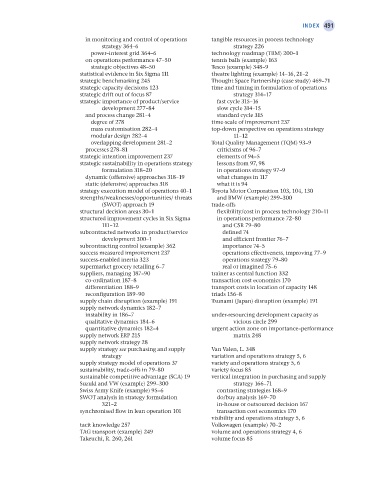Page 516 - Operations Strategy
P. 516
Index 491
in monitoring and control of operations tangible resources in process technology
strategy 364–6 strategy 226
power–interest grid 364–6 technology roadmap (TRM) 200–1
on operations performance 47–50 tennis balls (example) 163
strategic objectives 48–50 Tesco (example) 348–9
statistical evidence in Six Sigma 111 theatre lighting (example) 14–16, 21–2
strategic benchmarking 245 Thought Space Partnership (case study) 469–71
strategic capacity decisions 123 time and timing in formulation of operations
strategic drift out of focus 87 strategy 314–17
strategic importance of product/service fast cycle 315–16
development 277–84 slow cycle 314–15
and process change 281–4 standard cycle 315
degree of 278 time-scale of improvement 237
mass customisation 282–4 top-down perspective on operations strategy
modular design 282–4 11–12
overlapping development 281–2 Total Quality Management (TQM) 93–9
processes 278–81 criticisms of 96–7
strategic intention improvement 237 elements of 94–5
strategic sustainability in operations strategy lessons from 97, 98
formulation 318–20 in operations strategy 97–9
dynamic (offensive) approaches 318–19 what changes in 117
static (defensive) approaches 318 what it is 94
strategy execution model of operations 40–1 Toyota Motor Corporation 103, 104, 130
strengths/weaknesses/opportunities/ threats and BMW (example) 299–300
(SWOT) approach 19 trade-offs
structural decision areas 30–1 flexibility/cost in process technology 210–11
structured improvement cycles in Six Sigma in operations performance 72–80
111–12 and CSR 79–80
subcontracted networks in product/service defined 74
development 300–1 and efficient frontier 76–7
subcontracting control (example) 362 importance 74–5
success measured improvement 237 operations effectiveness, improving 77–9
success-enabled inertia 323 operations strategy 79–80
supermarket grocery retailing 6–7 real or imagined 75–6
suppliers, managing 187–90 trainer as central function 332
co-ordination 187–8 transaction cost economics 170
differentiation 188–9 transport costs in location of capacity 148
reconfiguration 189–90 triads 156–8
supply chain disruption (example) 191 Tsunami (Japan) disruption (example) 191
supply network dynamics 182–7
instability in 186–7 under-resourcing development capacity as
qualitative dynamics 184–6 vicious circle 299
quantitative dynamics 182–4 urgent action zone on importance–performance
supply network ERP 215 matrix 248
supply network strategy 28
supply strategy see purchasing and supply Van Valen, L. 348
strategy variation and operations strategy 5, 6
supply strategy model of operations 37 variety and operations strategy 5, 6
sustainability, trade-offs in 79–80 variety focus 85
sustainable competitive advantage (SCA) 19 vertical integration in purchasing and supply
Suzuki and VW (example) 299–300 strategy 166–71
Swiss Army Knife (example) 95–6 contrasting strategies 168–9
SWOT analysis in strategy formulation do/buy analysis 169–70
321–2 in-house or outsourced decision 167
synchronised flow in lean operation 101 transaction cost economics 170
visibility and operations strategy 5, 6
tacit knowledge 257 Volkswagen (example) 70–2
TAG transport (example) 249 volume and operations strategy 4, 6
Takeuchi, R. 260, 261 volume focus 85
Z20 Operations Strategy 62492.indd 491 09/03/2017 14:48

